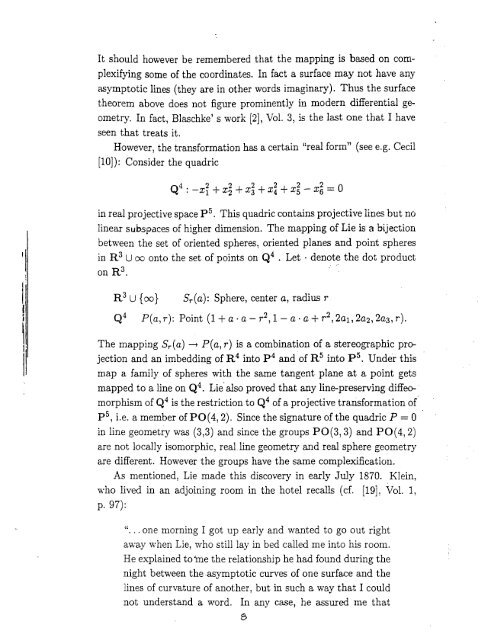Sophus Lie, the mathematician
Sophus Lie, the mathematician
Sophus Lie, the mathematician
Create successful ePaper yourself
Turn your PDF publications into a flip-book with our unique Google optimized e-Paper software.
IIt should however be remembered that <strong>the</strong> mapping is based on complexifyingsome of <strong>the</strong> coordinates. In fact a surface may not have anyasymptotic lines (<strong>the</strong>y are in o<strong>the</strong>r words imaginary). Thus <strong>the</strong> surface<strong>the</strong>orem above does not figure prominently in modern differential geometry.In fact, Blaschke' s work [2], Vol. 3, is <strong>the</strong> last one that I haveseen that treats it.However, <strong>the</strong> transformation has a certain "real form" (see e.g. Cecil[10]): Consider <strong>the</strong> quadricQ 4 : _ 2 + 2 + 2 = 0in real projective space P 5 . This quadric contains projective lines but nolinear subspaces of higher dimension. The mapping of <strong>Lie</strong> is a bijectionbetween <strong>the</strong> set of oriented spheres, oriented planes and point spheresin R 3 U 0o onto <strong>the</strong> set of points on Q4 . Let denote <strong>the</strong> dot producton R 3 .R; 3 U Coo} Sr(a): Sphere, center a, radius rQ 4 P(a,r): Point (1 + aa-r 2 ,1-a +ra , 2 2al,2a2,2a3,r).I, The mapping Sr (a) - P(a, r) is a combination of a stereographic projectionand an imbedding of R 4 into P 4 and of R 5 into P 5 . Under thismap a family of spheres with <strong>the</strong> same tangent plane at a point getsmapped to a line on Q 4 . <strong>Lie</strong>' also proved that any line-preserving diffeomorphismof Q 4 is <strong>the</strong> restriction to Q 4 of a projective transformation ofP 5 , i.e. a member of PO(4, 2). Since <strong>the</strong> signature of <strong>the</strong> quadric P = 0in line geometry was (3,3) and since <strong>the</strong> groups PO(3, 3) and PO(4, 2)are not locally isomorphic, real line geometry and real sphere geometryare different. However <strong>the</strong> groups have <strong>the</strong> same complexification.As mentioned, <strong>Lie</strong> made this discovery in early July 1870. Klein,who lived in an adjoining room in <strong>the</strong> hotel recalls (cf. [19], Vol. 1,p. 97):"... one morning I got up early and wanted to go out rightaway when <strong>Lie</strong>, who still lay in bed called me into his room.He explained tome <strong>the</strong> relationship he had found during <strong>the</strong>night between <strong>the</strong> .asymptotic curves of one surface and <strong>the</strong>"lines of curvature of ano<strong>the</strong>r, but in such a way that I couldnot understand a word. In any case, he assured me thatS
















